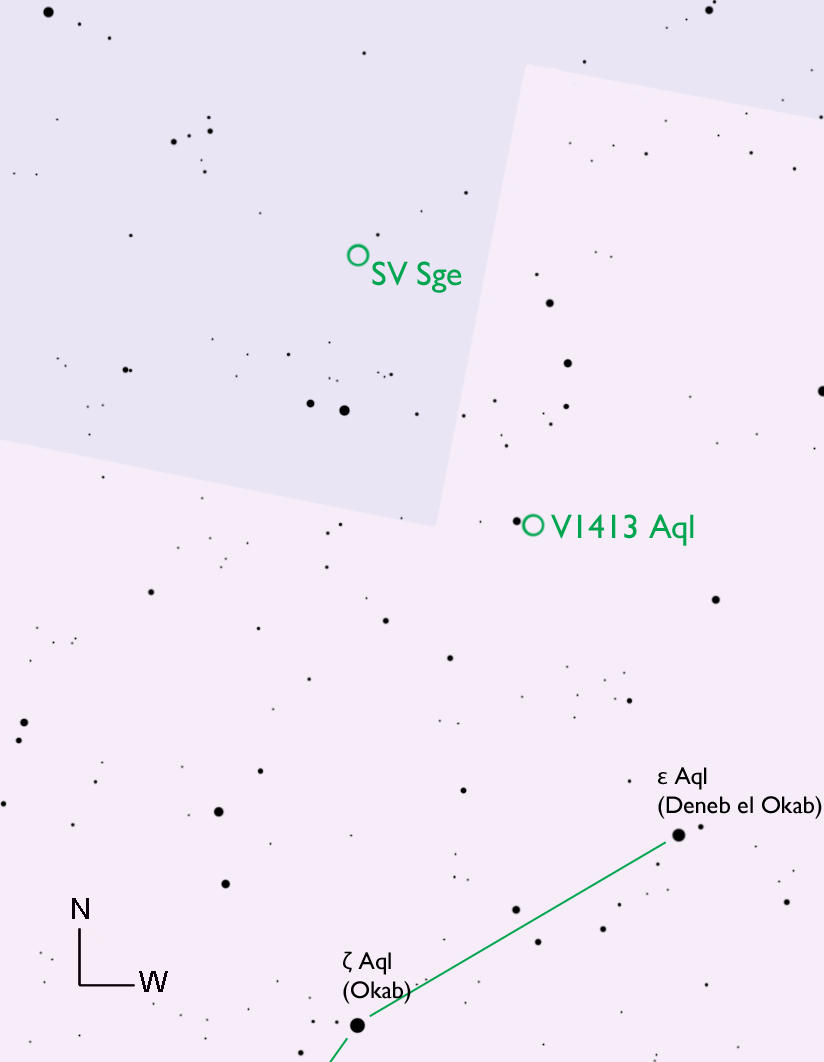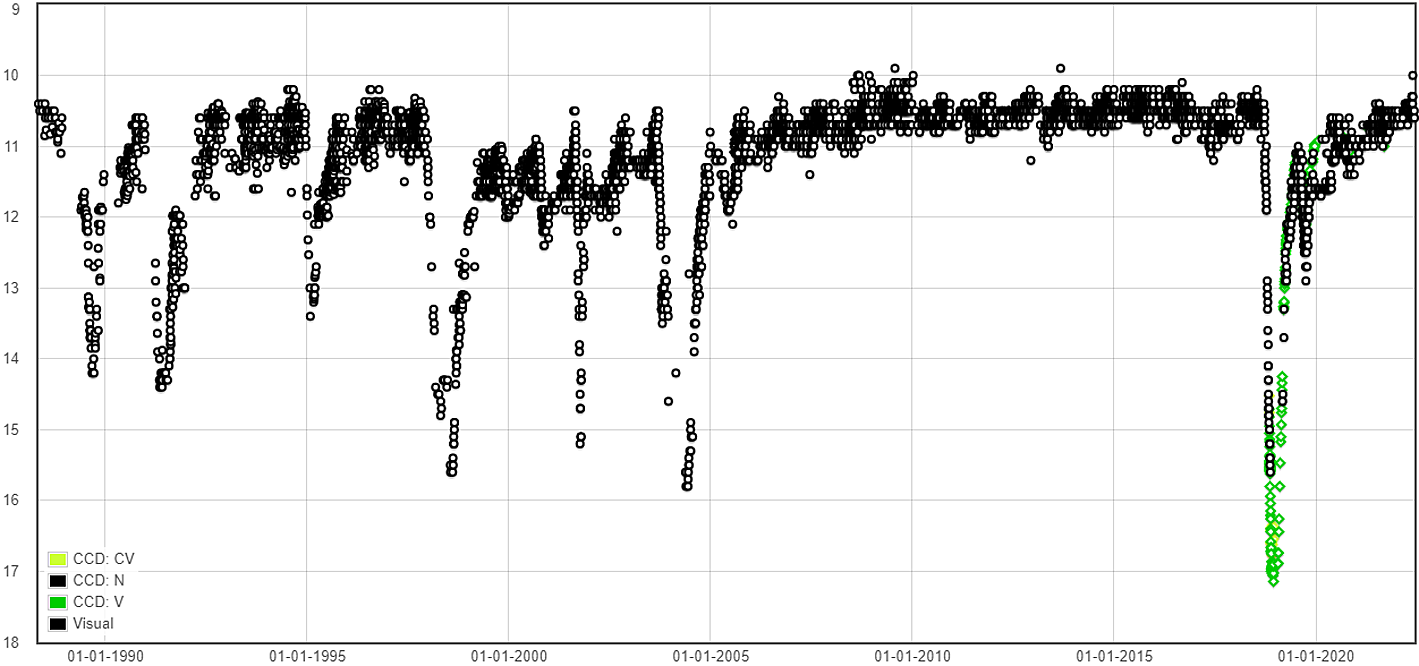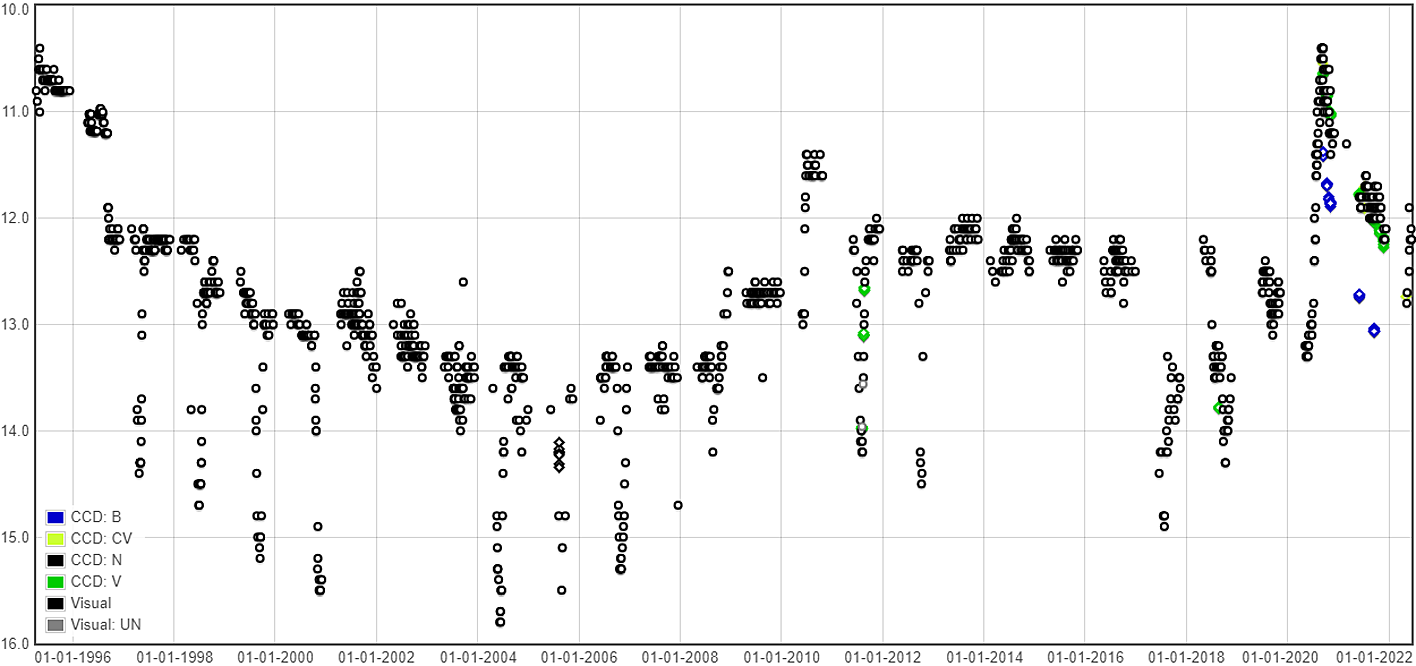Two interesting variables in Sagitta & Aquila
2022 August 7
Very often, the visual variable star observer will find that in the crowded Milky Way areas of the night sky, it is possible to observe a number of variables with the minimum movement of telescope or binoculars – even, on occasions, in the same field of view. Straddling the northern border of Aquila and western edge of Sagitta are two interesting variable stars just 1.5 degrees apart, completely different in their make-up. They are excellent objects for small or large telescopes, either visually or with a CCD during the summer months.

illustrative purposes only. (Philip Jennings & Gary
Poyner, with astrometry courtesy of Stellarium)
SV Sge (RA 19h 08m 11.77s, Dec. +17° 37ʹ 41.2ʺ) is one of the rarest types of variable stars in the night sky – type RCB, named after the prototype R Corona Borealis. These objects are all F–G supergiants and contain little or no hydrogen at all, but consist mainly of carbon, cyanogen, helium and various metals. Their light variations are caused by ‘clouds of dusty carbon’ ejected from the star itself. If one of these clouds happens to lie in the line of sight of an observer on Earth, the star is seen to fade, and can take weeks, months or years to recover to its usual brightness.
SV Sge has been monitored by the BAA Variable Star Section (VSS) since 1988, and since that time nine fades have been observed. The fades and recoveries cannot be predicted, making the RCB-type variables some of the most interesting to monitor on a regular basis. At maximum brightness, SV Sge is easily visible with small telescopes, shining between magnitudes 10 and 11. The fades vary in depth but can drop as deep as magnitude 17 (as in the last recorded fade in 2018 December), where a CCD will be needed to record it (Figure 1).

Just 1.5 degrees southwest over the border, in Aquila, can be found a fascinating symbiotic variable star – V1413 Aql (RA 19h 03m 46.84s, Dec. +16° 26ʹ 17.0ʺ). Symbiotic stars are binary systems containing a late-type giant star and a hot, compact companion – usually a white dwarf. Discovered in 1950 by Merrill & Burwell on plates taken at Mount Wilson, V1413 Aql’s symbiotic nature was not identified until 1984.1 What makes this star so interesting is that its variations have three distinct properties – a quiescent variability, outbursts and well-defined eclipses.
Figure 2 shows the Section’s light curve from 1995 to the present. One can see that the amplitude of variations excluding eclipses is over three magnitudes, ranging from 10.3–13.5 visual. This also includes three observed outbursts – 1995, 2010 and the historically bright 2021 event: excellent for 15–20cm telescopes or sizeable binoculars.

The eclipses occur every 434.1 days, with the duration and depth varying depending on the intrinsic brightness of the system as a whole. Observations undertaken by the writer from 1999–2011 show that the depth of the eclipse varies between 1.8 magnitudes when V1413 Aql is bright, to 2.3 magnitudes when fainter (visual), with the duration ranging from 64 days in low state to 85 days if the system is bright.2 This year’s mid-eclipse occurred during early April, and unfortunately no observations were made due to the unfavourable position of the field in the morning sky at that time. Despite this, the intrinsic variability and possibility of outbursts make V1413 Aql a very interesting star to observe during the second half of the year.
The 2023 mid-eclipse is due in early June and will be an excellent target for observers both visual and CCD. More information on this will hopefully appear in the spring 2023 edition of the VSS Circular, in March next year.
Charts for SV Sge are available to download from the VSS website,3 and for V1413 Aql can be downloaded from the AAVSO Variable Star Plotter.4
Gary Poyner, Coordinator, Cataclysmic Variables & Eruptive Stars
1 Munari U., ‘Studies of Symbiotic Stars VI. The eclipsing symbiotic nova AS 338’, Astron. Astrophys., 257, 163–176 (1992)
2 Poyner G., ‘Eclipse comparisons of the symbiotic nova V1413 Aql from visual photometry’, J. Br. Astron. Assoc., 122(6) (2012)
3 BAA VSS website: britastro.org/vss/
4 AAVSO charts: aavso.org/vsp
https://britastro.org/wp-content/uploads/2022/08/5dField_6cm.tif
https://britastro.org/wp-content/uploads/2022/08/svsge-1.tif
| The British Astronomical Association supports amateur astronomers around the UK and the rest of the world. Find out more about the BAA or join us. |
